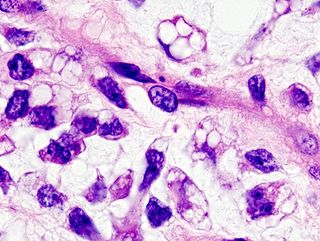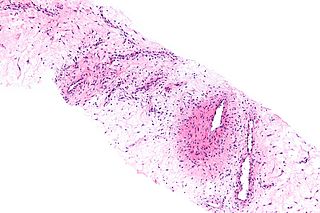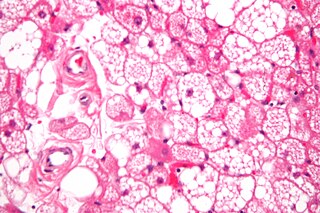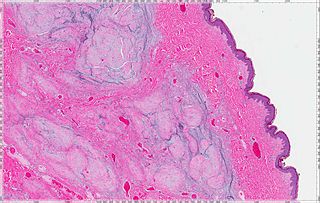
A lipoma is a benign tumor made of fat tissue. They are generally soft to the touch, movable, and painless. They usually occur just under the skin, but occasionally may be deeper. Most are less than 5 cm in size. Common locations include upper back, shoulders, and abdomen. A few people have a number of lipomas.

A sarcoma is a cancer that arises from transformed cells of mesenchymal origin. Connective tissue is a broad term that includes bone, cartilage, fat, muscle, vascular, or hematopoietic tissues, and sarcomas can arise in any of these types of tissues. As a result, there are many subtypes of sarcoma, which are classified based on the specific tissue and type of cell from which the tumor originates. It is important to note that sarcomas are primary connective tissue tumors, meaning that they arise in connective tissues. This is in contrast to secondary connective tissue tumors, which occur when a cancer from elsewhere in the body spreads to the connective tissue. The word sarcoma is derived from the Greek σάρξ sarx meaning "flesh".

A myxoma is a myxoid tumor of primitive connective tissue. It is most commonly found in the heart but can also occur in other locations.

A leiomyoma, also known as fibroids, is a benign smooth muscle tumor that very rarely becomes cancer (0.1%). They can occur in any organ, but the most common forms occur in the uterus, small bowel, and the esophagus. Polycythemia may occur due to increased erythropoietin production as part of a paraneoplastic syndrome.

Liposarcoma is a cancer that arises in fat cells in soft tissue, such as that inside the thigh or in the retroperitoneum. It is a rare type of cancer that bears a resemblance to fat cells when examined under a microscope. It is typically a large, bulky tumor, and tends to have multiple smaller satellites that extend beyond the main confines of the tumor. Liposarcomas, like all sarcomas, are rare.

Trabectedin is an antitumor chemotherapy drug sold by Pharma Mar S.A. and Johnson and Johnson under the brand name Yondelis. It is approved for use in Europe, Russia, and South Korea for the treatment of advanced soft-tissue sarcoma. It is also undergoing clinical trials for the treatment of breast, prostate, and paediatric sarcomas. The European Commission and the U.S. Food and Drug Administration (FDA) have granted orphan drug status to trabectedin for soft-tissue sarcomas and ovarian cancer.

DNA damage-inducible transcript 3, also known as C/EBP homologous protein (CHOP), is a pro-apoptotic transcription factor that is encoded by the DDIT3 gene.

RNA-binding protein FUS/TLS is a protein that in humans is encoded by the FUS gene.

Angiomyxoma is a myxoid tumor involving the blood vessels.

A hibernoma is a benign neoplasm of vestigial brown fat. The term was originally used by Gery in 1914.
Benign lipoblastomatosis is a tumor frequently confused with a liposarcoma, affecting exclusively infants and young children, with approximately 90% occurring before 3 years of age.

Neurothekeoma is a benign cutaneous tumor first described by Gallager and Helwig, who proposed the term in order to reflect the presumed origin of the lesion from nerve sheath. Microscopically, the lesions described closely resembled the tumor, "nerve sheath myxoma", an entity first described by Harkin and Reed. The latter had, through the years, been variously described as "Bizarre cutaneous neurofibroma", "Myxoma of nerve sheath", and "Pacinian neurofibroma".

A cutaneous myxoma, or superficial angiomyxoma, consists of a multilobulated myxoid mass containing stellate or spindled fibroblasts with pools of mucin forming cleft-like spaces. There is often a proliferation of blood vessels and an inflammatory infiltrate. Staining is positive for vimentin, negative for cytokeratin and desmin, and variable for CD34, Factor VIIIa, SMA, MSA and S-100.

Trichoepithelioma is a neoplasm of the adnexa of the skin. Its appearance is similar to basal cell carcinoma.

A Myxoid cyst is a cutaneous condition often characterized by nail plate depression and grooves.

Lipoblastoma is a type of subcutaneous benign fatty tumor.
Tegumental angiomyxoma-neurothekeoma is a syndrome, an acronym, and eponym proposed by Malaysian ophthalmologist of Chinese Descent, Tan Aik Kah. Angiomyxomas are associated with LAMB syndrome, NAME syndrome and Carney syndrome.
Tracy Ashton is an American film and television actress. She earned a degree from Southern Illinois University in dance. In all her roles Tracy Ashton appears as disabled girls and women, because her left leg is amputated above the knee. One of her best known roles was a recurring role as Didi in the television series My Name Is Earl.
A myxoid tumor is a connective tissue tumor with a "myxoid" background, composed of clear, mucoid substance.















